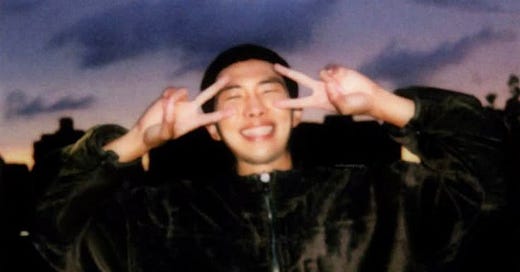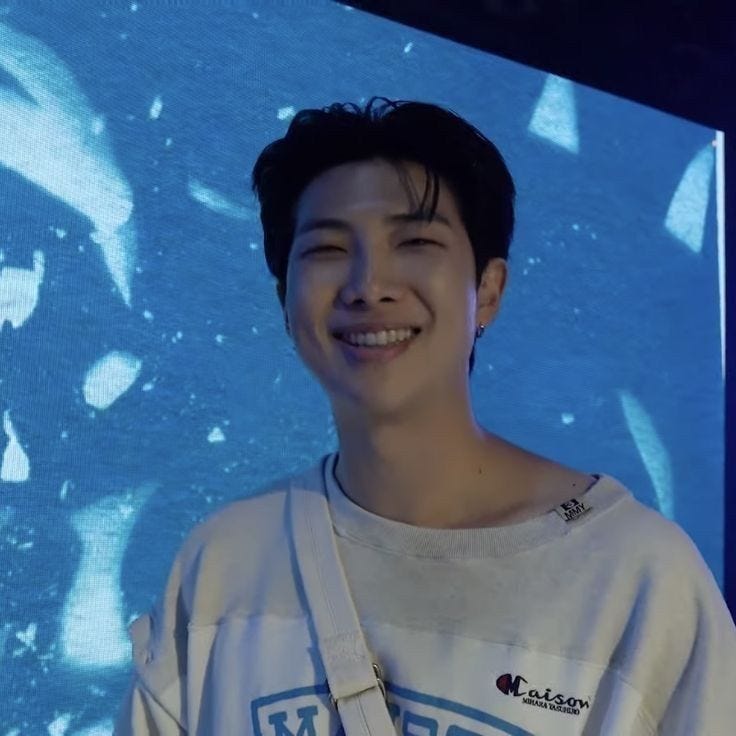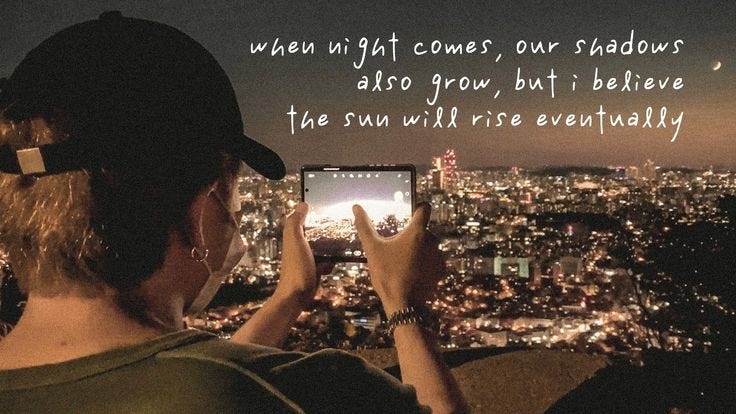"Even if I die tomorrow, I made this. I lived." — RM, Indigo
Here’s a little song to go with the essay (and if you are listening to RM newly, then it’s perfect)—
The Myth of Twenty-Seven: Memory as Mortality
There is a peculiar chill that accompanies the phrase “The 27 Club”—a whispered tally of brilliant, burning lives that expired too soon. Janis Joplin. Jimi Hendrix. Kurt Cobain. Amy Winehouse. All dead at 27. They live on not merely in the songs they left behind, but in the lore that surrounds them—myths of talent too incandescent for this world, swallowed by the very spotlight they sought.
But the 27 Club is no statistical anomaly—it is a cultural myth, a performance of romanticized ruin. As Roland Barthes would say, it is a mythology: an idea that presents itself as natural and inevitable, when it is in fact a social construct—a narrative loop replayed endlessly by media, fans, and institutions that commodify death. Behind the glamorized idea of “dying young” lies an uncomfortable question: why do we remember these deaths so vividly, and what does it mean to live beyond them?
In 2023, Kim Namjoon—better known as RM of BTS—turned 29. He had lived past 27. He did so quietly, intentionally, and with the grace of a man haunted but unbroken. And in doing so, he reframed what memory could mean—not just for those who left, but for those who chose to stay.
Seductive Fatalism: How We Aestheticize Death
Our cultural memory does not mourn—it curates. Susan Sontag, in Regarding the Pain of Others, warned us that the images of trauma risk becoming spectacle, muting our capacity to respond ethically. The 27 Club has become exactly that—a gallery of beautiful corpses. Death, in these cases, is not merely an endpoint but a genre, a moodboard, a t-shirt design.
When Amy Winehouse died, her album sales spiked by 3,400%. Documentaries were produced. Biopics commissioned. Kurt Cobain became a brand, a symbol of anti-establishment disillusion, ironically preserved in museums of capitalist memory. The tragedy is not just that they died—it is that we remember them less as people and more as aesthetic archetypes. Memory becomes a product, trauma becomes consumable.
What is lost in this packaging is the ethical encounter with the actual suffering that preceded their deaths. Depression, addiction, disillusionment—these are not glamorous. They are messy, unspeakable, slow erosions of the self. But pop culture rarely wants the truth. It wants spectacle. And in that spectacle, we lose the human.
The Korean Mirror: Silence, Toxicity, and the Weight of Perfection
This fatal romanticism finds a chilling parallel in Korean pop culture—a world where the cost of fame is measured not in drug overdoses, but in silence. In the last decade alone, the Korean entertainment industry has lost several young idols—Jonghyun of SHINee, Sulli of f(x), Goo Hara of KARA—many around the age of 27. Their deaths were not accidental—they were slow-burn suicides, cultivated by systems that demand perfection and punish vulnerability.
Jonghyun's last words—“Tell me I did well”—echo with haunting clarity. In Korea, where the philosophy of han (한) permeates the emotional landscape, pain is often endured, not expressed. Han is the unresolved sorrow that simmers quietly—a collective, inherited trauma. In the idol system, this sorrow festers in private dressing rooms, beneath carefully curated smiles.
Sulli, branded a “feminist” for her refusal to conform to demure femininity, became the target of brutal online harassment. Goo Hara’s legal battle with an abusive ex-partner was not met with support but skepticism. In the Korean digital ecosystem—especially on platforms like Naver and Daum—anonymity breeds vitriol. Idol mortality in Korea is not about drugs and guitars—it is about silence, shame, and the inability to be anything less than perfect.
The 27 Club lives here too. It just doesn’t always wear the same clothes.
RM: A Counter-Memory, A Surviving Archive
In this context, RM’s decision to live—not merely survive, but to live with intention—becomes radical. When he released Indigo, his first full solo album after turning 28, it read less like a victory lap and more like a living will. The album is laced with meditations on death, art, impermanence, and the aching beauty of trying to stay alive in a world that constantly demands your soul in exchange for relevance.
In “Yun,” RM raps: “I wanna be a human / ‘Fore I do some art / It’s a cruel world / But there's gon’ be my part.” This is not the voice of someone enthralled by the 27 Club—it’s the voice of someone digging his way out.
RM doesn’t just make art—he curates it. He collects paintings, references the Korean poet Yi Sang, visits museums like one visits cathedrals. His relationship to art is archival, not ephemeral. He does not chase virality; he traces lineage. In doing so, he becomes a kind of cultural cartographer—mapping survival not as resistance, but as a mode of being.
Michel Foucault once described “technologies of the self” as ways individuals shape themselves through acts of reflection and practice. RM embodies this: a man constantly reconstructing selfhood through reading, writing, walking, breathing. He has refused the flattening gaze of fame. He has built a multi-dimensional self in a world that demands flatness.
Ethical Memory: Mourning Without Consuming
The ethical dilemma remains: how do we remember those who have died without consuming them? How do we honor without mythologizing? Judith Butler, in Precarious Life, argues that certain lives are deemed more grievable than others. The media explosion around Western rock legends stands in stark contrast to how K-pop suicides are often covered—as personal tragedies, not systemic failures.
RM resists this consumption. He does not speak of Jonghyun often. But when he does, it is with respect, not spectacle. He doesn’t use grief as content. Instead, he speaks of life—quiet walks, favorite books, mental health appointments, military service. His life is not a performance—it is a practice.
Fans, too, have adapted. ARMY, the BTS fandom, has created digital rituals of grief and solidarity: hashtags like #YouDidWellJonghyun, mental health fundraisers in Sulli’s name, art exhibitions, fan fiction, poetry. These are not just memorials—they are acts of co-survival. A new memory is being written—not in headlines, but in community.
Surviving as a Form of Art
To grow old in the music industry is an act of defiance. In the K-pop world, idols are often discarded by thirty. RM, now in military service, is quietly becoming something rare: an artist aging in real time, not behind the curtain but in full view.
This aging is not decay—it is deepening. Indigo was not an album of hits—it was an album of truths. Each track a meditation. Each lyric a quiet rebellion against disposability.
Compare this to Leonard Cohen or Bob Dylan—artists who transformed age into poetics. RM walks this lineage. He does not belong to the 27 Club because he does not fetishize youth. He matures. He reflects. He continues.
Even in enlistment, he did not perform nationalism—he approached it as an ordinary act of citizenship. Not spectacle, but civic duty. This ordinariness is powerful. In a world obsessed with virality, ordinariness is resistance.
Conclusion: The Club Never Joined
There is a reason RM never joined the 27 Club. It is not because he was luckier or stronger. It is because he refused the myth. He chose not to die young, not because it was easy, but because it was necessary. Because he understood that the real rebellion is to live. To keep showing up to therapy. To keep writing. To walk into a museum on a rainy day and cry in front of a painting. To age. To endure.
The 27 Club should never have been a club—it should have been a warning. And RM, with his tender strength, his evolving selfhood, and his refusal to be consumed, is not just a survivor. He is a rewriter of memory.
He reminds us that living is not less poetic than dying. Sometimes, it is the most poetic thing we can do.
Writer’s Note
I’ve been listening to BTS for eight years now—long enough for a whole era of my life to have been shaped, softened, shattered, and rebuilt in the echo of their music. What started as songs on a playlist soon became lifelines. In midnight moments when the world closed in, I didn’t need answers—just a voice. And BTS, always, had one for me. They didn’t just sing; they reached for me. They saw the ache beneath the armor.
Namjoon—RM—was the first voice that truly felt like a mirror. His words, equal parts cerebral and soul-deep, have been the anchor when I drifted too far into doubt. His vulnerability gave me permission to feel mine. His quiet strength taught me that soft doesn’t mean weak, and that intellect can be stitched with heart. In a world that often demands we harden or hide, he showed me how to stand tender and unshaken.
He once said: “Maybe I made a mistake yesterday, but yesterday’s me is still me. I am who I am today, with all of my faults and my mistakes. Tomorrow, I might be a tiny bit wiser, and that’s me too.” And that quote—God, it’s stitched into me. Because healing isn’t a race. Selfhood isn’t a performance. And to grow while holding onto your imperfections is a kind of revolution.
This essay isn’t just an intellectual exploration—it’s personal. It's my way of honoring the lives that were lost and the ones still being lived. It’s for every artist who chose to stay, for every fan who chose to hold on, and for the tender miracle of surviving.
To Namjoon: thank you for showing me that the act of living—quietly, thoughtfully, bravely—is its own kind of poetry. You didn’t just help me hear music. You helped me listen to myself.
With love, always—
a grateful, breathing, growing ARMY.
Mukta







